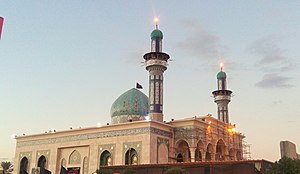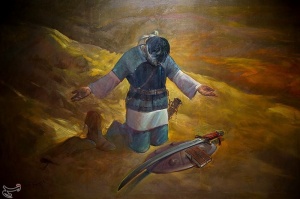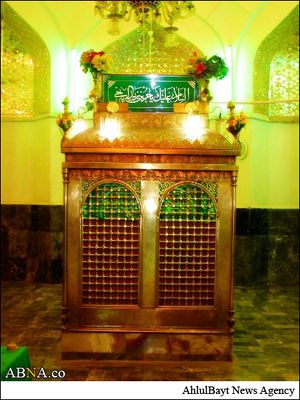Horr B. Yazid al-Riahi al-Yarbuʾi al-Tamimi
Horr B. Yazid al-Riahi al-Yarbuʾi al-Tamimi | |
|---|---|
 | |
| Native name | حر بن یزید ریاحی |
| Died | 61/680 (Martyred in the Event of Ashura) |
| Resting place | Karbala, Iraq |
| Known for | Battle of Karbala |
Horr B. Yazid al-Riahi al-Yarbuʾi al-Tamimi (d. 61/ 680), a leading tribesman in Kufa, who obeyed the orders of ʿUbayd-Allah b. Ziad by intercepting Hussain b. ʿAli and his party and leading them to Karbala, but later repented and fought on Hussain’s side which led to Horr’s martyrdom on the 10th of Muharram, Ashura. He is regarded as the symbol of hope in repentance which ensures his salvation.
Encounter with Imam Hussain
The first meeting between Horr and Imam Hussain was not hostile. However, Horr pressed upon Hussain to change his course and follow him, even after the latter had informed him of the letters of support, he had received from the Kufans, towards whom his party was heading. Horr further obeyed Ibn-e Ziad’s subsequent order to force the rebels to stop in a deserted area. Thus, Hussain was led to the plain of Karbala, where he was encircled by the troops dispatched by Ibn-e Ziad under the command of ʿOmar b. Saʿd. Once the latter had rejected Hussain’s final proposals and decided to fight him on the morning of Ashura, 10 Muharram 61/10 October 680, Horr then repented and joined Hussain, who promised him God’s forgiveness.
Horr’s Martyrdom
According to most historians, many men from Hussain’s side were killed before Horr.[1] However, Horr’s own words when he rallied behind Hussain imply that he might have been the first to be killed at Karbala. Shiʿite tradition has retained this sequence of events, apparently derived from the work of Shaykh al-Mofid, who does not mention anyone having been killed before Horr, except Muslim b. ʿAwsaja.[2] In Turco-Persian maqtal-nama narratives of the drama of Karbala, which were used extensively by Kashefi for his Rawzat al-Shuhada (see Calmard, 1996, p. 155), after having killed many enemies, Horr became the first martyr of the battle. His martyrdom was followed by those of his brother, Moṣʿab b. Yazid, his son ʿAli, and the latter’s slave.[3]
Legacy
Horr’s courageous rallying behind Hussain and sacrificing himself to his cause are widely celebrated in Muharram rituals and related popular literature, such as marthia (elegies), nawha (dirges), and Ta'ziya (religious dramas). Many scenes dedicated to Horr are included in taʿzia collections, particularly in the Cerulli version.[4]
References
Bibliography
- M. Ayoub, Redemptive Suffering in Islam, The Hague, 1978, Index.
- J. Calmard, “Le Culte de l’Imam Hussain. Etude sur la commémoration du drame de Karbala dans l’Iran pré-safavide,” Ph.D. diss., University of Paris (Sorbonne), 1975.
- Idem, “Shií Rituals and Power, II. The Consolidation of Safavid Shi’ism: Folklore and Popular Religion,” in C. Melville, ed., SafavidPersia, Cambridge, 1996, pp. 139-90.
- P. J. Chelkowski, ed., Taʿziyeh: Ritual and Drama in Iran, New York, 1979, index. Ṣ. Homāyuni, Taʿzia dar Irān, Shiraz, 1368 Š./1989, Index.
- Hussain Wāʿeẓ Kāšefi, Rawżat al-šohadāʾ, ed. M. Ramażāni, Tehran, 1341 Š./1962.
- M. J. Kister, “al-Ḥurr b. Yazīd,” in EI2. Šayḵ al-Mofid, al-Eršād, tr. I. K. A. Howard, Kitāb al-Iršād: The Book of Guidance in the Livesof the Twelve Imams, London, 1981, Index.
- Mostawfi, Šarḥ-e zendagāni. E. Rossi and A. Bombaci, Elenco di drammi religiosipersiani (fondo mss. Vaticani Cerulli), Vatican City, 1961, Index.
- P. Ṣayyād, Matn-e taʿzia-e Ḥorr, mansub be-Moṣṭafā Kāšāni (Mir ʿAzā), Tehran, 1350 Š./1971.
- Ṭabari, II, index; Ṭabari tr., XIX, index. L. Veccia Vaglieri, “al-Ḥusayn b. ʿAlī b. Abī Ṭālib,” in EI².

